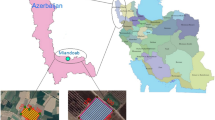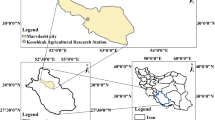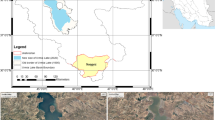Abstract
Iran is located in an arid and semi-arid region of the world; however, more than 90% of Iran’s total water is allocated to agricultural sector. Owing to the climatic limitations of the country, agricultural water management has become one of the country’s greatest concerns. Therefore, the present study has attempted to identify optimal locations in terms of high yield and low total water footprint (WF) (m3/$) in the northwest and southeast provinces of the country to produce main cereals such as wheat, barley, and maize. In this regard, inverse distance weighting (IDW) method was first employed 150 sample coordinates to prepare interpolation maps of evapotranspiration (ETc) (mm), irrigation requirements (IR) (mm), nitrogen application (kg/ha), and effective precipitation (Peff) (mm). Subsequently, green WF, blue WF, gray WF, total WF (TWF) (m3/ton), and economical total WF (ETWF) (m3/$) maps were prepared for each crop. Multiple linear regression (MLR) was then applied to determine the correlation between ETWF (m3/$) and other parameters. ETWF (m3/$) was later predicted using multiple linear regression (MLR), in conjunction with artificial neural networks (ANNs) including multilayer perceptron (MLP) and radial basis function (RBF). Findings showed that IDW can be applied with a relatively low error so that an interpolation map for each parameter can be obtained and the changes can be examined. The results of MLR indicated that for assessing the yield of barley and wheat the TWF possesses and for assessing the yield of maize, the IR model had the highest rate of regression. The results of ANN indicated that the RBF (R2 = 0.901), the RBF (R2 = 0.882), and the MLP (R2 = 0.947) were the most appropriate models for the prediction and evaluation of ETWF and yield with respect to measured estimates of ETWF (m3/$) and yield of wheat, barley, and maize (in order of appropriability).





Similar content being viewed by others
References
Ababaei B, Etedali HR (2014) Estimation of water footprint components of Iran’s wheat production: comparison of global and national scale estimates. Environ Process 1(3):193–205
Ababaei B, Etedali HR (2017) Water footprint assessment of main cereals in Iran. Agric Water Manag 179:401–411
Aldaya MM, Chapagain AK, Hoekstra AY, Mekonnen MM (2012) The water footprint assessment manual: setting the global standard. Routledge, London
Arabi Yazdi A, Niknia N, Majidi N, Emami H (2015) Water security assessment in arid climates based on water footprint concept (case study; south Khorasan province). Iran J Irrig Drain 4(8):735–746 (in Persian)
Bai X, Ren X, Khanna NZ, Zhang G, Zhou N, Bai Y, Hu M (2018) A comparative study of a full value-chain water footprint assessment using two international standards at a large-scale hog farm in China. J Clean Prod 176:557–565
Bocchiola D, Nana E, Soncini A (2013) Impact of climate change scenarios on crop yield and water footprint of maize in the Po valley of Italy. Agric Water Manag 116:50–61
Cerdà A, Rodrigo-Comino J, Giménez-Morera A, Novara A, Pulido M, Kapović-Solomun M, Keesstra SD (2018) Policies can help to apply successful strategies to control soil and water losses. The case of chipped pruned branches (CPB) in Mediterranean citrus plantations. Land Use Policy 75:734–745
Chapagain AK, Hoekstra AY, Savenije HHG (2006) Water saving through international trade of agricultural products. Hydrol Earth Syst Sci Discuss 10(3):455–468
Chukalla AD, Krol MS, Hoekstra AY (2015) Green and blue water footprint reduction in irrigated agriculture: effect of irrigation techniques, irrigation strategies and mulching. Hydrol Earth Syst Sci 19(12):4877–4891
Darré E, Cadenazzi M, Mazzilli SR, Rosas JF, Picasso VD (2019) Environmental impacts on water resources from summer crops in rainfed and irrigated systems. J Environ Manag 232:514–522
Dawson CW, Wilby R (1998) An artificial neural network approach to rainfall-runoff modelling. Hydrol Sci J 43(1):47–66
Deihimfard R, Eyni-Nargeseh H, Mokhtassi-Bidgoli A (2018) Effect of future climate change on wheat yield and water use efficiency under semi-arid conditions as predicted by APSIM-wheat model. Int J Plant Product:1–11. https://doi.org/10.1007/s42106-018-0012-4
Garofalo P, Ventrella D, Kersebaum KC, Gobin A, Trnka M, Giglio L, Dubrovský M, Castellini M (2018) Water footprint of winter wheat under climate change: trends and uncertainties associated to the ensemble of crop models. Sci Total Environ 658:1186–1208. https://doi.org/10.1016/j.scitotenv.2018.12.279
Gerbens-Leenes W, Hoekstra AY, van der Meer TH (2009) The water footprint of bioenergy. Proc Natl Acad Sci 106(25):10219–10223
Han Y, Jia D, Zhuo L, Sauvage S, Sánchez-Pérez JM, Huang H, Wang C (2018) Assessing the water footprint of wheat and maize in Haihe River Basin, Northern China (1956–2015). Water 10(7):867
Hoekstra AY, Chapagain AK (2006) Water footprints of nations: Water use by people as a function of their consumption pattern. In: Craswell E, Bonnell M, Bossio D, Demuth S, Van De Giesen N (eds) Integrated Assessment of Water Resources and Global Change. Springer, Dordrecht. https://doi.org/10.1007/978-1-4020-5591-1_3.
Hoekstra AY, Chapagain AK (2008) Globalization of water: sharing the planet’s freshwater resources. Blackwell Publishing, Oxford
Kalantari K, Maknoon R, Karimi D (2018) Developing sustainable legal framework for the establishment of integrated water resources management in Iran. Int J Environ Res 12(2):223–231
Karandish F, Šimůnek J (2018) An application of the water footprint assessment to optimize production of crops irrigated with saline water: a scenario assessment with HYDRUS. Agric Water Manag 208:67–82
Levis S, Badger A, Drewniak B, Nevison C, Ren X (2018) CLMcrop yields and water requirements: avoided impacts by choosing RCP 4.5 over 8.5. Clim Chang 146(3–4):501–515
López-López M, Espadador M, Testi L, Lorite IJ, Orgaz F, Fereres E (2018) Water use of irrigated almond trees when subjected to water deficits. Agric Water Manag 195:84–93
Lovarelli D, Bacenetti J, Fiala M (2016) Water footprint of crop productions: a review. Sci Total Environ 548:236–251
Lowe D, Broomhead D (1988) Multivariable functional interpolation and adaptive networks. Complex Syst 2(3):321–355
Madani K (2014) Water management in Iran: what is causing the looming crisis? J Environ Stud Sci 4(4):315–328
Masud MB, McAllister T, Cordeiro MR, Faramarzi M (2018) Modeling future water footprint of barley production in Alberta, Canada: implications for water use and yields to 2064. Sci Total Environ 616:208–222
Meena RP, Sharma RK, Sendhil R, Tripathi SC, Gill SC (2018) Quantifying water productivity using seed priming and micro irrigation in wheat (Triticum aestivum). JWR 10(1):20–24
Mekonnen MM, Hoekstra AY (2011) National water footprint accounts: the green, blue and grey water footprint of production and consumption, Value of Water Research Report Series No 50, UNESCO-IHE, Delft, the Netherlands
Mesgaran MB, Onofri A, Mashhadi HR, Cousens RD (2017) Water availability shifts the optimal temperatures for seed germination: a modelling approach. Ecol Model 351:87–95
Minasny B, McBratney AB, Bristow KL (1999) Comparison of different approaches to the development of pedotransfer functions for water-retention curves. Geoderma 93(3–4):225–253
Mojtabavi SA, Shokoohi A, Ramezani Etedali H, Singh V (2018) Using regional virtual water trade and water footprint accounting for optimizing crop patterns to mitigate water crises in dry regions. Irrig Drain 67(2):295–305
Mokarram M, Hamzeh S, Aminzadeh F, Zarei AR (2015) Using machine learning for land suitability classification. West Afr J App Ecol 23(1):63–73
Montazar A, Zadbagher E (2010) An analytical hierarchy model for assessing global water productivity of irrigation networks in Iran. Water Resour Manag 24(11):2817–2832
Nouri H, Stokvis B, Galindo A, Blatchford M, Hoekstra AY (2019) Water scarcity alleviation through water footprint reduction in agriculture: the effect of soil mulching and drip irrigation. Sci Total Environ 653:241–252
Núñez-López JM, Hernández-Calderón OM, Ponce-Ortega JM, Cervantes-Gaxiola ME, Rubio-Castro E (2018) Optimal design of sustainable agricultural water networks. ACS Sustain Chem Eng 7(1):440–457
Perea RG, Morillo JG, Díaz JAR, Barrios PM, Poyato EC (2018) Water footprint accounting for improving irrigation management in olive trees. In Water scarcity and sustainable agriculture in semiarid environment (pp. 61-72). https://doi.org/10.1016/B978-0-12-813164-0.00003-X
Pourjafarinejad G, Alizadeh A, Neshat A (2013) Study on ecological water footprint and indicators of virtual water in agricultural section of Kerman Province. Iran J Irrig Water 4(13):80–89 (in Persian)
Powell MJD (1987) Radial basis functions for multivariable interpolation: a review. In: Mason JC, Cox MG (eds) Proceedings of IMA conference on algorithms for approximation. Oxford University Press, New York, pp 143–167
Schaap MG, Leij FJ (1998) Using neural networks to predict soil water retention and soil hydraulic conductivity. Soil Tillage Res 47(1–2):37–42
Schils R, Olesen JE, Kersebaum KC, Rijk B, Oberforster M, Kalyada V, Khitrykau M, Gobin A, Kirchev H, Manolova V, Manolov I (2018) Cereal yield gaps across Europe. Eur J Agron 101:109–120
Shtull-Trauring E, Bernstein N (2018) Virtual water flows and water-footprint of agricultural crop production, import and export: a case study for Israel. Sci Total Environ 622:1438–1447
SPSS I (2010) SPSS for windows (version 20). Chicago, Ill
Stričević RJ, Srđević ZB, Đurović NL, Srđević BM (2018) The agricultural water footprint and assessment of virtual water trade: does Serbia import or export water? J Agric Sci 63(2):185–194
Stricevic RJ, Stojakovic N, Vujadinovic-Mandic M, Todorovic M (2018) Impact of climate change on yield, irrigation requirements and water productivity of maize cultivated under the moderate continental climate of Bosnia and Herzegovina. J Agric Sci 156(5):618–627
Sudheer KP, Gosain AK, Ramasastri KS (2002) A data-driven algorithm for constructing artificial neural network rainfall-runoff models. Hydrol Process 16(6):1325–1330
Zarei AR (2018) Evaluation of drought condition in arid and semi-arid regions, using RDI Index. Water Resour Manag 32(5):1689–1711
Zarei AR, Moghimi MM (2019a) Modified version for SPEI to evaluate and modeling the agricultural drought severity. Int J Biometeorol 63(7):911–925
Zarei AR, Moghimi MM (2019b) Environmental assessment of semi-humid and humid regions based on modeling and forecasting of changes in monthly temperature. Int J Environ Sci Technol 16(3):1457–1470
Zhao Y, Ding D, Si B, Zhang Z, Hu W, Schoenau J (2019) Temporal variability of water footprint for cereal production and its controls in Saskatchewan, Canada. Sci Total Environ 660:1306–1316. https://doi.org/10.1016/j.scitotenv.2018.12.410
Zhuo L, Mekonnen MM, Hoekstra AY, Wada Y (2016) Inter-and intra-annual variation of water footprint of crops and blue water scarcity in the Yellow River basin (1961–2009). Adv Water Resour 87:29–41
Acknowledgments
The authors would like to thanks to all personnel of Agricultural Jihad of Fars province for providing the necessary data.
Funding
Shiraz University and Imam Khomeini International University provided financial support (grant number: 249026-198) for this study.
Author information
Authors and Affiliations
Corresponding author
Ethics declarations
Conflict of interest
The authors declare that they have no conflict of interest.
Additional information
Publisher’s note
Springer Nature remains neutral with regard to jurisdictional claims in published maps and institutional affiliations.
Electronic supplementary material
ESM 1
(DOCX 3374 kb)
Rights and permissions
About this article
Cite this article
Mokarram, M., Zarei, A.R. & Etedali, H.R. Optimal location of yield with the cheapest water footprint of the crop using multiple regression and artificial neural network models in GIS. Theor Appl Climatol 143, 701–712 (2021). https://doi.org/10.1007/s00704-020-03413-y
Received:
Accepted:
Published:
Issue Date:
DOI: https://doi.org/10.1007/s00704-020-03413-y




